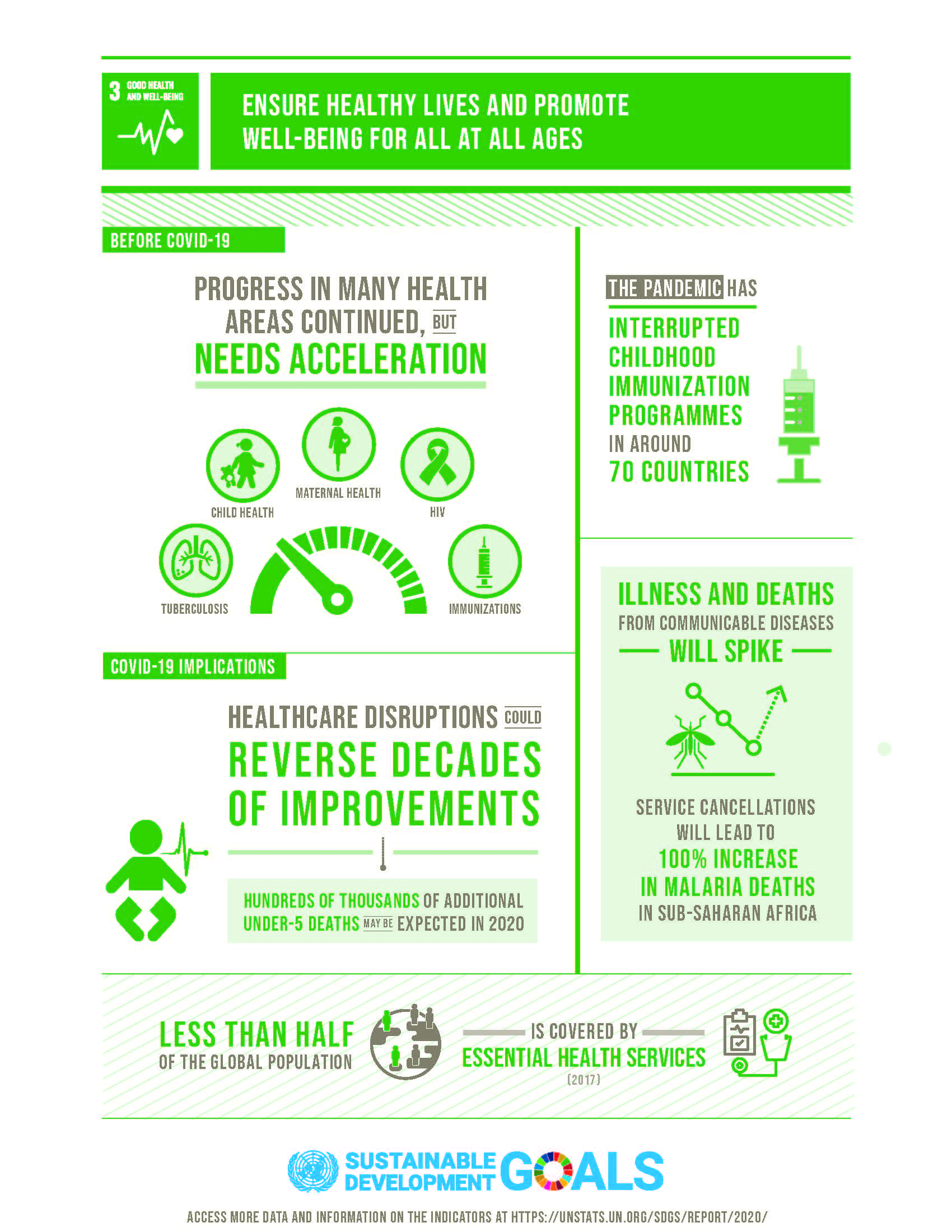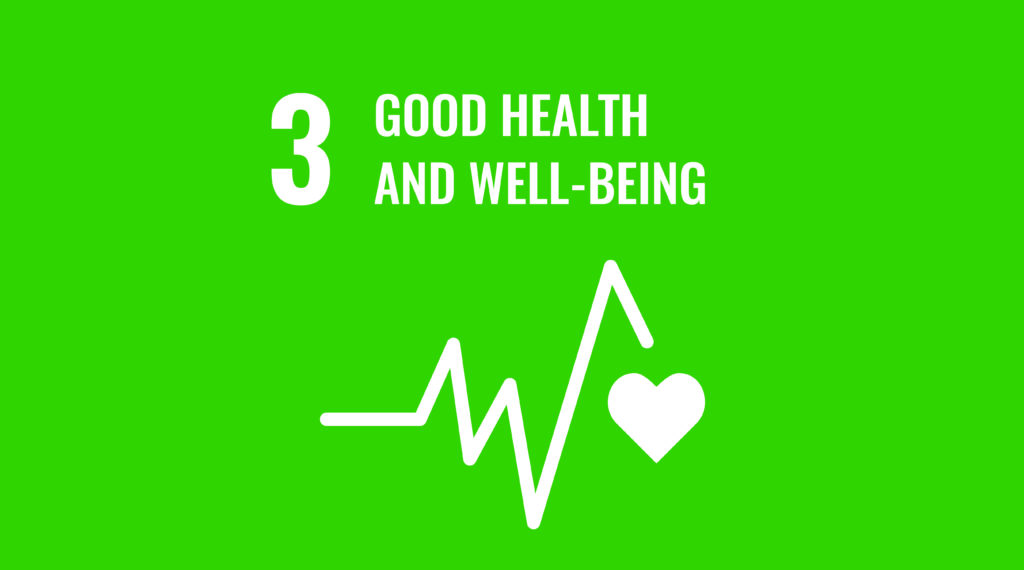Good Health
Ensuring good healthy lives and promoting well-being at all ages is essential to sustainable development. Currently, the world is facing a global health crisis unlike any other — COVID-19 is spreading human suffering, destabilizing the global economy and upending the lives of billions of people around the globe.
Before the pandemic, major progress was made in improving the health of millions of people. Significant strides were made in increasing life expectancy and reducing some of the common killers associated with child and maternal mortality. But more efforts are needed to fully eradicate a wide range of diseases and address many different persistent and emerging health issues. By focusing on providing more efficient funding of good health systems, improved sanitation and hygiene, and increased access to physicians, significant progress can be made in helping to save the lives of millions.
Health emergencies such as COVID-19 pose a global risk and have shown the critical need for preparedness. The United Nations Development Programme highlighted huge disparities in countries’ abilities to cope with and recover from the COVID-19 crisis. The pandemic provides a watershed moment for health emergency preparedness and for investment in critical 21st century public services.
Sustainable Development Goals
The 2030 Agenda for Sustainable Development was adopted by all United Nations Member states in 2015, an agenda that provides a shared blueprint for peace and prosperity for people and the planet, now and into the future.
The 17 Sustainable Development Goals (SDGs) are an urgent call for action by all countries – developed and developing – in a global partnership. They recognize that ending poverty and other deprivations must go hand-in-hand with strategies that improve good health and education, reduce inequality, and spur economic growth – all while tackling climate change and working to preserve our oceans and forests. Learn more about the UN SDG’s.

What’s the goal here?
To ensure good healthy lives and promote well-being for all at all ages.
Why?
Ensuring good healthy lives and promoting well-being is important to building prosperous societies.
However, the COVID-19 pandemic has devastated health systems globally and threatens already achieved health outcomes. Most countries, especially poor countries, have insufficient health facilities, medical supplies and health care workers for the surge in demand.
The pandemic has shown that in rich and poor countries alike, a health emergency can push people into bankruptcy or poverty.
Concerted efforts are required to achieve universal good health coverage and sustainable financing for health; address the growing burden of zoonotic and non-communicable diseases, tackle antimicrobial resistance and environmental factors contributing to ill health.
What progress have we made so far?
Progress in many health areas, such as in reducing maternal and child mortality, in increasing coverage of immunization, and in reducing some infectious diseases, continues, but the rate of improvement has slowed down, especially during COVID-19 which is overwhelming the health systems globally and threatens health outcomes already achieved.
How can we achieve these targets?
Ensuring good healthy lives for all requires a strong commitment, but the benefits outweigh the cost. Healthy people are the foundation for healthy economies. Immunization is one of the world’s most successful and cost-effective health interventions. While vaccination coverage among infants increased from 72 per cent in 2000 to 86 per cent in 2018, an estimated 19.4 million children did not receive the essential vaccines during the first year of life. In fact, since March 2020, routine childhood immunization services have been disrupted on a scale not seen since the inception of the Expanded Programme on Immunization in the 1970s.
Does everyone have access to healthcare?
In 2017, only around one third to half of the global population was covered by essential health services. If current trends continue, only 39 per cent to 63 per cent of the global population will be covered by essential good health services by 2030. The COVID-19 crisis has disrupted essential health services around the world. Some services have been suspended to free up resources for COVID-19 patients and to reduce the risk of transmission. If universal good health coverage is to become a reality by 2030, growth in the provision and use of essential health services must greatly accelerate.
What can I do to help?
You can start by promoting and protecting your own health and the health of those around you, by making well-informed choices, practicing safe sex and vaccinating your children. You can raise awareness in your community about the importance of good health, healthy lifestyles as well as people’s right to quality health care services, especially for the most vulnerable such as women and children.
You can also hold your government, local leaders and other decision-makers accountable to their commitments to improve people’s access to health and good health care.
United Nation Sustainable Development Goals
(United Nations why it matters)
Facts and Figures
Child health
- In 2018 an estimated 6.2 million children and adolescents under the age of 15 years died, mostly from preventable causes. Of these deaths, 5.3 million occurred in the first 5 years, with almost half of these in the first month of life.
- Despite determined global progress, an increasing proportion of child deaths are in Sub-Saharan Africa and Southern Asia. Four out of every five deaths of children under age five occur in these regions.
- Children in sub-Saharan Africa are more than 15 times more likely to die before the age of 5 than children in high income countries.
- Malnourished children, particularly those with severe acute malnutrition, have a higher risk of death from common childhood illness such as diarrhoea, pneumonia, and malaria. Nutrition-related factors contribute to about 45per cent of deaths in children under-5 years of age.
Maternal health
- Over 40 per cent of all countries have fewer than 10 medical doctors per 10,000 people; over 55 per cent of countries have fewer than 40 nursing and midwifery personnel per 10,000 people.
- In Eastern Asia, Northern Africa and Southern Asia, maternal mortality has declined by around two-thirds.
- Every day in 2017, approximately 810 women died from preventable causes related to pregnancy and childbirth.
- 94per cent of all maternal deaths occur in low and lower middle-income countries.
- Young adolescents (ages 10-14) face a higher risk of complications and death as a result of pregnancy than other women.
- But maternal mortality ratio – the proportion of mothers that do not survive childbirth compared to those who do – in developing regions is still 14 times higher than in the developed regions.
HIV/AIDS, malaria and other diseases
- 38 million people globally were living with HIV in 2019.
- 25.4 million people were accessing antiretroviral therapy in 2019.
- 1.7 million people became newly infected with HIV in 2019.
- 690 000 people died from AIDS-related illnesses in 2019.
- 75.7 million people have become infected with HIV since the start of the epidemic.
- 32.7 million people have died from AIDS-related illnesses since the start of the epidemic.
- Tuberculosis remains the leading cause of death among people living with HIV, accounting for around one in three AIDS-related deaths.
- Globally, adolescent girls and young women face gender-based inequalities, exclusion, discrimination and violence, which put them at increased risk of acquiring HIV.
- HIV is the leading cause of death for women of reproductive age worldwide.
- AIDS is now the leading cause of death among adolescents (aged 10–19) in Africa and the second most common cause of death among adolescents globally.
- Over 6.2 million malaria deaths have been averted between 2000 and 2015, primarily of children under five years of age in sub-Saharan Africa. The global malaria incidence rate has fallen by an estimated 37 per cent and the mortality rates by 58 per cent.
Goal 3 targets
- 3.1 By 2030, reduce the global maternal mortality ratio to less than 70 per 100,000 live births.
- 3.2 By 2030, end preventable deaths of newborns and children under 5 years of age, with all countries aiming to reduce neonatal mortality to at least as low as 12 per 1,000 live births and under-5 mortality to at least as low as 25 per 1,000 live births.
- 3.3 By 2030, end the epidemics of AIDS, tuberculosis, malaria and neglected tropical diseases and combat hepatitis, water-borne diseases and other communicable diseases.
- 3.4 By 2030, reduce by one third premature mortality from non-communicable diseases through prevention and treatment and promote mental health and well-being.
- 3.5 Strengthen the prevention and treatment of substance abuse, including narcotic drug abuse and harmful use of alcohol.
- 3.6 By 2020, halve the number of global deaths and injuries from road traffic accidents.
- 3.7 By 2030, ensure universal access to sexual and reproductive health-care services, including for family planning, information and education, and the integration of reproductive health into national strategies and programmes.
- 3.8 Achieve universal health coverage, including financial risk protection, access to quality essential health-care services and access to safe, effective, quality and affordable essential medicines and vaccines for all.
- 3.9 By 2030, substantially reduce the number of deaths and illnesses from hazardous chemicals and air, water and soil pollution and contamination.
- 3.A Strengthen the implementation of the World Health Organization Framework Convention on Tobacco Control in all countries, as appropriate.
- 3.B Support the research and development of vaccines and medicines for the communicable and noncommunicable diseases that primarily affect developing countries, provide access to affordable essential medicines and vaccines, in accordance with the Doha Declaration on the TRIPS Agreement and Public Health, which affirms the right of developing countries to use to the full the provisions in the Agreement on Trade Related Aspects of Intellectual Property Rights regarding flexibilities to protect public health, and, in particular, provide access to medicines for all.
- 3.C Substantially increase health financing and the recruitment, development, training and retention of the health workforce in developing countries, especially in least developed countries and small island developing States.
- 3.D Strengthen the capacity of all countries, in particular developing countries, for early warning, risk reduction and management of national and global health risks.
Links
WHO – Reducing Child Mortality
UNFPA Sexual & reproductive health
We, at AI for Good foundation, are using AI + ML initiatives in pursuit of the 17 SDGs. With various projects in progress, such as our Climate Trend Scanner and the SDG Data Catalog, we are determined to help and facilitate achieving the goals.







